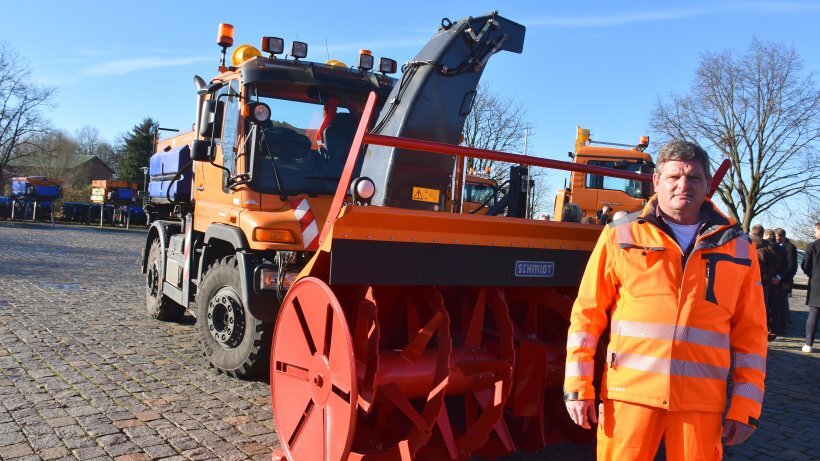A report by the Hamburger Abendblatt
It's that time of year again: At the weekend, temperatures dropped below freezing at night, causing slippery roads in northern Germany. To prevent drivers from slipping, the 26 motorway and road maintenance depots in Schleswig-Holstein are prepared: the clearing and gritting vehicles are ready, and 30,000 tonnes of salt are stored in 46 halls and silos throughout the state.
27 road wardens work at the motorway maintenance depot in Bad Oldesloe and are on duty 24 hours a day in winter if necessary. "We work in a three-shift system and are on call between 4 p.m. and 7.15 a.m.," explains Stefan Klempau, work group leader at the motorway maintenance office in Bad Oldesloe on the A 1. Their area of responsibility extends from the Hamburg-Ost motorway junction to Bad Schwartau (A 1), from the Bargteheide motorway junction to Leezen (A 21) and on the A 20 to Mecklenburg-Vorpommern. In both directions together, that is 204 kilometres of motorway. In addition, there are 59 kilometres of slip roads and exits. The operational area is divided into six sections. As a rule, there is one gritting truck per section. It takes about two hours to cover each kilometre.
The snow blower is needed when there is a lot of snow
If there is freezing rain or heavy snowfall, more vehicles and drivers from outside companies are called in. However, the motorway maintenance department provides the gritters as well as the snow ploughs, which are then attached to the vehicles. "If a layer of snow has already formed, we drive slightly offset with three cars over the three lanes of the A1 and thus push the snow to the side with the snow ploughs," Klempau explains. If there is a lot of snow, the Schmidt snow blower is used to blow the snow onto the fields. If only gritting is needed, one vehicle is sufficient for three lanes. "It can spread the grit over a width of twelve metres," explains Klempau. To clear the motorways of ice or snow, pre-wetted salt is used. For this purpose, the gritting vehicles are equipped with a tank for brine (sodium chloride solution) and a container for salt. When spreading, both substances are mixed (70 per cent salt, 30 per cent brine).
"Wet salt adheres better to the surface," explains Jens Sommerburg, head of the Landesbetrieb Straßenbau und Verkehr (LBV) in Lübeck: "If we only spread salt, it could be blown away by the wind." This would pollute the environment and the roads would remain dangerously slippery. To protect the environment, however, the LBV not only uses the salt-brine mixture, but also modern technology. Thus, the salt consumption could be significantly reduced. "For example, the spreader recognises how fast the vehicle is travelling and automatically adjusts the amount spread over the plate," Sommerburg explains.
Sensors measure temperatures and humidity
Modern technology is also used at the 64 weather stations on the motorways. On the A1 between Hamburg and Fehmarn alone, there are nine of these so-called road weather information systems. "Sensors at the station and in the roadway measure, among other things, temperature, humidity, road temperature, whether there is snowfall or whether there is still enough salt on the roadway," Sommerburg explains. With this data, operations could be better coordinated. Although this technology has been around since the mid-1990s, the sensors have been improved over the years. They also calculate a forecast.
The motorway maintenance department uses this data, as well as information from the German Weather Service, to take preventive action. "In this way we can distribute pure brine on the carriageway as a preventive measure," says Carolin Rönna, deputy head of the motorway maintenance department. On the one hand, a layer of ice does not form so quickly, and on the other, snow can be cleared more easily because it does not stick to the road. The brine, which has a salt concentration of 22 per cent, is produced by the motorway maintenance department in Bad Oldesloe itself and has a 40,000-litre tank for it on the premises. In addition, 850 tonnes of road salt are stored in a hall and 150 tonnes in a silo. So that the gritting vehicles do not always have to drive to the motorway maintenance depot for reloading, there is also a storage hall in Barsbüttel (600 tonnes of salt) and a silo (250 tonnes of salt) in Hamberge.
Even though the motorway maintenance services try to get the motorway clear again as quickly as possible in winter, Transport Minister Bernd Buchholz appeals to motorists: "Everyone should now be on the road with winter tyres and adapt their driving to the weather conditions."
